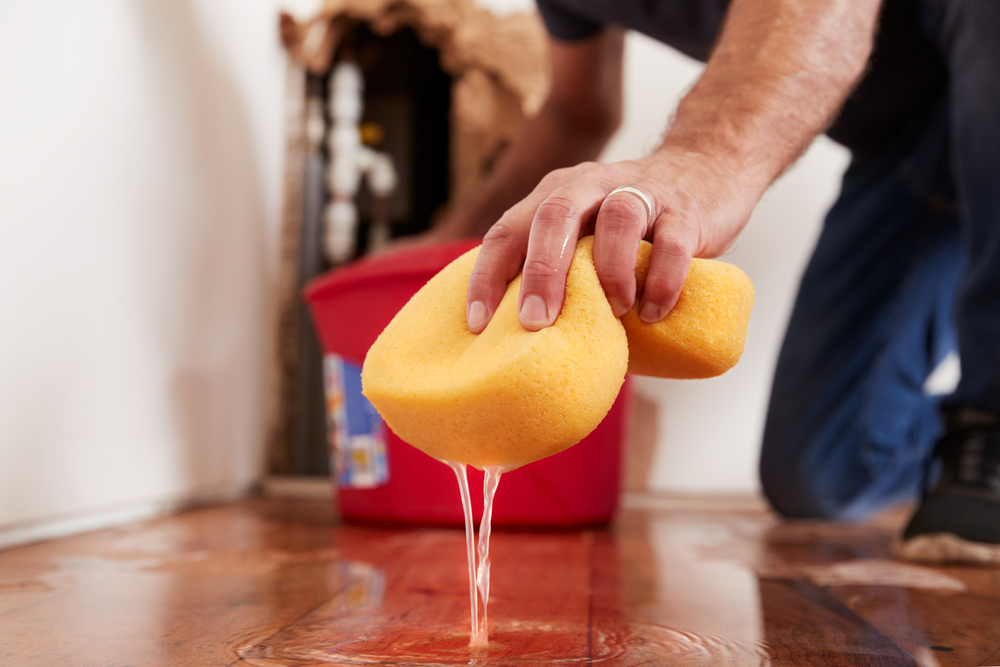A burst pipe can cause severe water damage in a matter of minutes, ruining flooring, walls, and valuable possessions. While waiting for a plumber is unavoidable in most cases, the actions you take in those first moments are critical. By recognising the warning signs early and knowing the right steps to follow, you can protect your property, reduce repair costs, and keep your household safe. This guide explains how to identify a burst pipe quickly, control the damage, and prepare for professional repairs.

1. Identify the Signs of a Burst Pipe
In Brisbane’s warm climate, burst pipes are more likely to be caused by ageing plumbing, corrosion, tree root intrusion, or high water pressure rather than freezing conditions. Spotting the signs early can make a huge difference in preventing serious damage.
A sudden drop in water pressure when using taps, showers, or appliances is one of the first warning signs. You may also notice unexplained puddles in your yard, damp spots on walls or ceilings, or sections of carpet and flooring that feel wet or uneven. In some cases, you might hear hissing, dripping, or rushing water sounds even when no water is being used.
Another common indicator is an unexpected increase in your water bill, which can point to a hidden leak. Outdoors, look for unusually green or soggy patches of lawn that could signal an underground burst pipe. The sooner you recognise these signs, the faster you can act to reduce water loss and property damage.
2. Shut Off the Water Supply Immediately
Once you suspect or confirm a burst pipe, your first priority is to stop more water from escaping into your home. Locate your property’s main water shut-off valve. In most Brisbane homes, this is found outside near the water meter, often at the front boundary or close to the street. The valve usually has a tap-style handle or lever. Turn it clockwise until it is fully closed to cut off the water supply.
It is a good idea to familiarise yourself with the valve’s location before an emergency happens. If you live in an apartment, check with building management as the shut-off point may be inside a service cupboard or a shared access area. Acting quickly can prevent hundreds of litres of water from flooding your property, which means less damage to flooring, cabinetry, and electrical systems.
If the valve is difficult to turn or stuck, avoid forcing it as this could cause more damage. In this case, call your water provider or an emergency plumber immediately for assistance. Shutting off the water is the single most effective way to limit damage until professional repairs can begin.
3. Turn Off Electricity in Affected Areas
Water and electricity are a dangerous combination, so safety should be your next priority once the water supply has been shut off. If water from the burst pipe has reached electrical outlets, appliances, or light fittings, switch off the power to those areas at your home’s switchboard. In many Brisbane homes, the switchboard is located on an external wall or inside the garage. Turn off the individual circuit breakers for the affected rooms, or switch off the main power if you are unsure which circuits are involved.
Avoid touching any electrical appliances or outlets that are wet or submerged, as this can result in electric shock. If the flooding is severe, it is safest to leave the property and wait for a licensed electrician or emergency services to confirm the area is safe before re-entering.
Turning off the electricity in the affected zones not only reduces the risk of injury but also helps prevent further damage to appliances and wiring. This simple precaution can make the repair process faster and safer once the plumber and other professionals arrive.
4. Drain Remaining Water from the System
Once the main water supply is turned off, there will still be water sitting in the pipes. Draining it can help relieve pressure, reduce the amount of water escaping through the damaged section, and limit further flooding.
Start by turning on the taps in your home, beginning with the lowest point, such as an outdoor garden tap or a ground-floor sink. Then work your way up to taps on higher levels. This allows gravity to help clear the water from the system. Flush all toilets to empty the cisterns and reduce the amount of standing water in the plumbing lines.
If you have a hot water system, turn it off and open the hot taps to drain it as well. This step helps protect the system from damage and prevents water from leaking through any burst hot water lines. Be cautious when handling hot water outlets to avoid burns, especially if the system has been running recently.
By draining the pipes, you reduce the risk of additional water leaks while waiting for the plumber. It also helps them start repairs more quickly when they arrive, as the system will already be depressurised.
5. Contain the Leak and Protect Belongings
After draining the system, focus on containing any remaining water and protecting your home and possessions from further damage. Start by placing buckets or large containers under the burst pipe or leak to catch dripping water. Use towels or absorbent cloths to soak up water on floors, and replace them regularly so they remain effective.
Move furniture, electronics, and personal items out of the affected area as quickly as possible. For heavy items that cannot be moved, cover them with waterproof sheets or plastic tarps to shield them from splashes and moisture. Rugs and carpets can be rolled up and taken outside to dry, which helps prevent mould growth.
If water has seeped into walls, ceilings, or cabinetry, improve ventilation by opening windows and doors where it is safe to do so. This allows air to circulate and can help slow down the spread of damage. Acting promptly to protect your belongings not only saves money on repairs or replacements but also reduces the stress of losing valuable or sentimental items.
6. Temporary Repairs to Reduce Leaks
While you wait for a plumber to arrive, you can make temporary repairs to slow or stop the leak. These fixes are not permanent solutions, but they can help limit water damage and buy you more time.
If the burst section of the pipe is visible and accessible, wrap it tightly with plumber’s tape, rubber from an old hose, or a thick cloth, then secure it with a clamp or strong tape. This creates a temporary seal that can reduce water loss. Commercial pipe repair kits, available from most hardware stores, can also be used if you have one on hand.
Avoid using makeshift repairs on high-pressure lines without first shutting off the main water supply, as this can cause the patch to fail. Do not attempt to cut or replace any sections of pipe yourself unless you are trained to do so, as this can lead to further damage or safety hazards.
These short-term measures are best used to contain the problem until a licensed plumber can carry out proper repairs. Once the professional arrives, let them know exactly what you have done so they can assess the situation and replace or repair the affected section safely.

7. Call an Emergency Plumber and Provide Key Details
Once you have taken steps to control the leak and limit the damage, contact an emergency plumber in Brisbane as soon as possible. The faster you call, the sooner they can get to you and complete the necessary repairs. When you speak to them, provide clear and detailed information about the situation.
Explain where the burst pipe is located, whether the water supply has been shut off, and what immediate actions you have already taken. Let them know if water has reached electrical outlets, flooring, or walls, as this may affect their repair approach. If you live in a multi-storey home or an apartment, mention which floors or units are affected so they can prepare the right tools and materials.
It is also helpful to confirm their estimated arrival time, so you can continue monitoring the area and be ready to give them access when they arrive. By sharing accurate details upfront, you make it easier for the plumber to bring the correct equipment and complete the job efficiently, reducing both repair time and potential costs.
8. Document the Damage for Insurance
If the burst pipe has caused significant damage to your home, documenting the situation thoroughly can make the insurance claim process smoother and increase the likelihood of having your costs covered. Start by taking clear photos and videos of the affected areas, showing the extent of the water damage to floors, walls, ceilings, furniture, and personal belongings. Capture both close-up and wide-angle shots to provide a full picture of the incident.
Make notes about when you first noticed the problem, the steps you took to control the damage, and any temporary repairs you attempted. Keep receipts for any emergency purchases, such as buckets, towels, tarps, or repair kits, as these may be claimable expenses. If you had to arrange urgent accommodation because the home became unsafe, keep all related documentation.
Once you have gathered your evidence, contact your insurance provider as soon as possible to report the claim. Provide them with the photos, videos, and notes so they can assess the situation accurately. Acting quickly and supplying thorough documentation can help speed up the approval process and ensure you receive the financial assistance you need for repairs and replacements.
Conclusion
A burst pipe can cause extensive damage in a short amount of time, but knowing what to do before help arrives can make all the difference. By recognising the early signs, shutting off the water supply, turning off electricity in affected areas, draining the system, and protecting your belongings, you can limit the impact and make repairs faster and safer. Temporary fixes and clear communication with an emergency plumber will help them address the problem efficiently, while documenting the damage ensures you have the information needed for an insurance claim. Acting quickly, staying calm, and following these steps can save you from costly repairs and help restore your home sooner.
-full-color-rgb-2000px-w-72ppi.webp)

